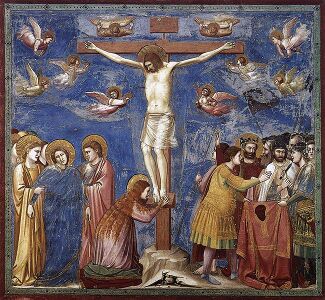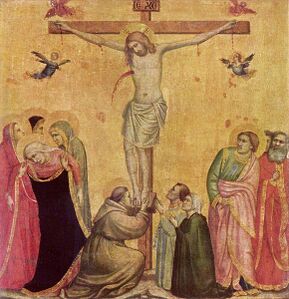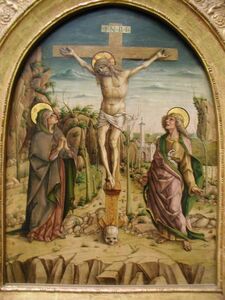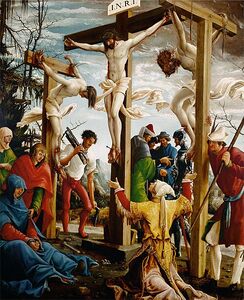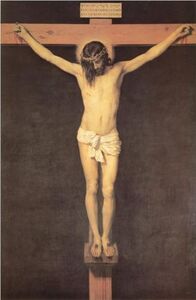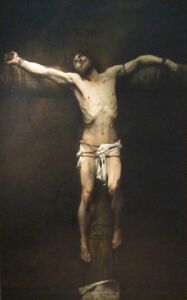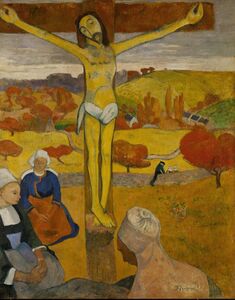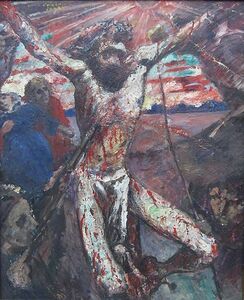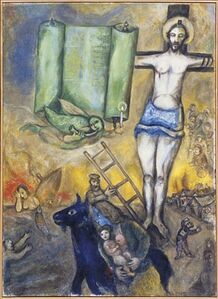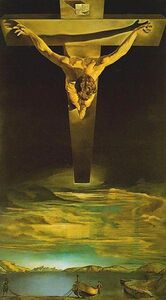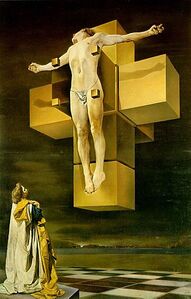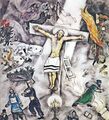Category:Crucifixion of Jesus (subject)
The Crucifixion of Jesus was an episode in the Passion of Jesus, according to the Gospels of Mark (15:20b-41); Matthew (27:31b-56), Luke (23:26-49), and John (19:17-37).
- Passion of Jesus : Triumphal Entry into Jerusalem -- Cleansing of the Temple -- Plot to Kill Jesus -- Anointing of Jesus -- Betrayal of Judas -- Last Supper -- Agony in the Garden -- Arrest of Jesus -- Trial of Jesus before the High Priest -- Peter's Denial -- Trial of Jesus before Pilate -- Trial of Jesus before Herod Antipas -- Barabbas -- Flagellation of Jesus -- Mocking of Jesus -- Way to Golgotha -- Crucifixion of Jesus -- Burial of Jesus
< Life of Jesus : Nativity of Jesus -- Childhood of Jesus -- Jesus' Hidden Years -- Ministry of Jesus (Parables of Jesus, Miracles of Jesus) -- Passion of Jesus -- Resurrection of Jesus -- Relics of Jesus >
< Life of Mary of Nazareth : Expulsion of Joachim from the Temple -- Annunciation to Anne and Joachim -- Birth of Mary -- Girlhood of Mary (Education of the Virgin, Presentation of Mary at the Temple) -- Marriage of Mary and Joseph -- Annunciation to Mary -- Visitation of Mary -- Birth of Jesus -- Adoration of the Shepherds -- Adoration of the Magi -- Circumcision of Jesus -- Presentation of Jesus at the Temple -- Massacre of the Innocents -- Flight into Egypt -- Jesus among the Doctors -- Death of Joseph of Nazareth -- Wedding at Cana -- Jesus' True Relatives -- Hometown Rejection -- Crucifixion of Jesus -- Resurrection of Jesus -- Ascension of Jesus -- Gathering of the Twelve at Jerusalem -- Christian Pentecost -- Death and Assumption of Mary -- Relics of Mary of Nazareth >
Overview
Crucifixion was a method of painful execution generally reserved by the Romans to fugitive slaves and political prisoners. Crucifixion was performed not only as a form of punishment but also to terrorize and dissuade the onlookers from perpetrating the crimes punishable by it.
The crucifixion of Jesus is one of the few events of the life of Jesus that are recorded even outside Christian sources (see Tacitus). Jesus was crucified as a political prisoner. All four Gospels report the official charge: "The King of the Jews." Roman soldiers carried on the execution.
On his way to the execution, Jesus was forced to carry the cross, or better the crossbeam, on his shoulders. According to the Synoptics, Jesus was so weak that the Romans soldiers compelled a passerby, Simon of Cyrene, to help him; see Way to Golgotha.
The place of execution was certainly outside the walls of Jerusalem along a road, near one of gates, so that passersby could look at it. It was known as the Place of the Skull (Mark, Matthew, and John provide the Hebrew name: Golgotha). This indicate that the place was commonly used for execution.
Jesus was executed with two other political prisoners. As customary, they were stripped of their clothes and crucified naked. They were offered "wine mixed with myrr" as a sedative.
The condemned were mocked and cursed by the soldiers and the passersby. According to Mark and Matthew, the crucified companions also taunted Jesus. Luke instead makes a distinction between the two.
Relatives, friends or followers were not allowed to accompany the condemned, nor were crowds allowed to assembly. People had to remain at a distance in small groups. The gospels agree that only some women followed Jesus "at a distance." The group did not include the mother of Jesus or any of his relatives and disciples. That Jesus could address that group of women (as Luke suggests) is virtually impossible; no communication was allowed between the condemned and the passersby. The Johannine narrative of the conversation between the crucified Jesus and his mother and disciple is symbolic; it could never have happened that women or relatives were allowed to "stand by the cross."
Jesus was crucified around 9am and died around 3pm. It was Friday and according to John, it was the eve of Passover. John makes Jesus die the very same moment in which the lambs for the sacrifice were slaughtered in the Temple. In order to emphasize the identity of Jesus of the Lamb of God, John clarifies that Jesus did not have his leg bones broken to speed his death (as it happened to the other people who were crucified with him, so that they should die before the beginning of the feast).
Crucifixion of Jesus, in ancient sources
Gospel of Mark
Mark 15:20b-41 (NRSV) -- [20] ...Then they led him out to crucify him. 21 They compelled a passer-by, who was coming in from the country, to carry his cross; it was Simon of Cyrene, the father of Alexander and Rufus.
[22] Then they brought Jesus to the place called Golgotha (which means the place of a skull). [23] And they offered him wine mixed with myrrh; but he did not take it. [24] And they crucified him, and divided his clothes among them, casting lots to decide what each should take. [25] It was nine o'clock in the morning when they crucified him. [26] The inscription of the charge against him read, "The King of the Jews."
[27] And with him they crucified two bandits, one on his right and one on his left. [28] [29] Those who passed by derided him, shaking their heads and saying, "Aha! You who would destroy the temple and build it in three days, [30] save yourself, and come down from the cross!" [31] In the same way the chief priests, along with the scribes, were also mocking him among themselves and saying, "He saved others; he cannot save himself. [32a] Let the Messiah, the King of Israel, come down from the cross now, so that we may see and believe." Those who were crucified with him also taunted him.
[33] When it was noon, darkness came over the whole land until three in the afternoon. 34 At three o'clock Jesus cried out with a loud voice, "Eloi, Eloi, lema sabachthani?" which means, "My God, my God, why have you forsaken me?" 35 When some of the bystanders heard it, they said, "Listen, he is calling for Elijah." [36] And someone ran, filled a sponge with sour wine, put it on a stick, and gave it to him to drink, saying, "Wait, let us see whether Elijah will come to take him down." [37] Then Jesus gave a loud cry and breathed his last. [38] And the curtain of the temple was torn in two, from top to bottom. [39] Now when the centurion, who stood facing him, saw that in this way he breathed his last, he said, "Truly this man was God's Son!"
[40] There were also women looking on from a distance; among them were Mary Magdalene, and Mary the mother of James the younger and of Joses, and Salome. [41] These used to follow him and provided for him when he was in Galilee; and there were many other women who had come up with him to Jerusalem.
Gospel of Matthew
Matthew 27:31b-56 (NRSV) -- Then they led him away to crucify him. 32 As they went out, they came upon a man from Cyrene named Simon; they compelled this man to carry his cross.
[33] And when they came to a place called Golgotha (which means Place of a Skull), 34 they offered him wine to drink, mixed with gall; but when he tasted it, he would not drink it. 35 And when they had crucified him, they divided his clothes among themselves by casting lots; 36 then they sat down there and kept watch over him. 37 Over his head they put the charge against him, which read, "This is Jesus, the King of the Jews."
[38] Then two bandits were crucified with him, one on his right and one on his left. [39] Those who passed by derided him, shaking their heads 40 and saying, "You who would destroy the temple and build it in three days, save yourself! If you are the Son of God, come down from the cross." 41 In the same way the chief priests also, along with the scribes and elders, were mocking him, saying, 42 "He saved others; he cannot save himself. He is the King of Israel; let him come down from the cross now, and we will believe in him. 43 He trusts in God; let God deliver him now, if he wants to; for he said, 'I am God's Son.'" 44 The bandits who were crucified with him also taunted him in the same way.
[45] From noon on, darkness came over the whole land until three in the afternoon. 46 And about three o'clock Jesus cried with a loud voice, "Eli, Eli, lema sabachthani?" that is, "My God, my God, why have you forsaken me?" 47 When some of the bystanders heard it, they said, "This man is calling for Elijah." 48 At once one of them ran and got a sponge, filled it with sour wine, put it on a stick, and gave it to him to drink. 49 But the others said, "Wait, let us see whether Elijah will come to save him." 50 Then Jesus cried again with a loud voice and breathed his last. 51 At that moment the curtain of the temple was torn in two, from top to bottom. The earth shook, and the rocks were split. 52 The tombs also were opened, and many bodies of the saints who had fallen asleep were raised. 53 After his resurrection they came out of the tombs and entered the holy city and appeared to many. 54 Now when the centurion and those with him, who were keeping watch over Jesus, saw the earthquake and what took place, they were terrified and said, "Truly this man was God's Son!" 55 Many women were also there, looking on from a distance; they had followed Jesus from Galilee and had provided for him. 56 Among them were Mary Magdalene, and Mary the mother of James and Joseph, and the mother of the sons of Zebedee.
Gospel of Luke
Luke 23:26-49 (NRSV) -- 26 As they led him away, they seized a man, Simon of Cyrene, who was coming from the country, and they laid the cross on him, and made him carry it behind Jesus. 27 A great number of the people followed him, and among them were women who were beating their breasts and wailing for him. 28 But Jesus turned to them and said, "Daughters of Jerusalem, do not weep for me, but weep for yourselves and for your children. 29 For the days are surely coming when they will say, 'Blessed are the barren, and the wombs that never bore, and the breasts that never nursed.' 30 Then they will begin to say to the mountains, 'Fall on us'; and to the hills, 'Cover us.' 31 For if they do this when the wood is green, what will happen when it is dry?" 32 Two others also, who were criminals, were led away to be put to death with him.
[33] When they came to the place that is called The Skull, they crucified Jesus there with the criminals, one on his right and one on his left. 34 Then Jesus said, "Father, forgive them; for they do not know what they are doing." And they cast lots to divide his clothing. 35 And the people stood by, watching; but the leaders scoffed at him, saying, "He saved others; let him save himself if he is the Messiah of God, his chosen one!" 36 The soldiers also mocked him, coming up and offering him sour wine, 37 and saying, "If you are the King of the Jews, save yourself!" 38 There was also an inscription over him, "This is the King of the Jews." 39 One of the criminals who were hanged there kept deriding him and saying, "Are you not the Messiah? Save yourself and us!" 40 But the other rebuked him, saying, "Do you not fear God, since you are under the same sentence of condemnation? 41 And we indeed have been condemned justly, for we are getting what we deserve for our deeds, but this man has done nothing wrong." 42 Then he said, "Jesus, remember me when you come into your kingdom." 43 He replied, "Truly I tell you, today you will be with me in Paradise."
[44] It was now about noon, and darkness came over the whole land until three in the afternoon, 45 while the sun's light failed; and the curtain of the temple was torn in two. 46 Then Jesus, crying with a loud voice, said, "Father, into your hands I commend my spirit." Having said this, he breathed his last. 47 When the centurion saw what had taken place, he praised God and said, "Certainly this man was innocent."
[48] And when all the crowds who had gathered there for this spectacle saw what had taken place, they returned home, beating their breasts. [49] But all his acquaintances, including the women who had followed him from Galilee, stood at a distance, watching these things.
Gospel of John
John 19:16b-37 (NRSV) -- So they took Jesus; 17 and carrying the cross by himself, he went out to what is called The Place of the Skull, which in Hebrew is called Golgotha. 18 There they crucified him, and with him two others, one on either side, with Jesus between them. 19 Pilate also had an inscription written and put on the cross. It read, "Jesus of Nazareth, the King of the Jews." 20 Many of the Jews read this inscription, because the place where Jesus was crucified was near the city; and it was written in Hebrew, in Latin, and in Greek. 21 Then the chief priests of the Jews said to Pilate, "Do not write, 'The King of the Jews,' but, 'This man said, I am King of the Jews.'" 22 Pilate answered, "What I have written I have written." 23 When the soldiers had crucified Jesus, they took his clothes and divided them into four parts, one for each soldier. They also took his tunic; now the tunic was seamless, woven in one piece from the top. 24 So they said to one another, "Let us not tear it, but cast lots for it to see who will get it." This was to fulfill what the scripture says, "They divided my clothes among themselves, and for my clothing they cast lots." 25 And that is what the soldiers did.
Meanwhile, standing near the cross of Jesus were his mother, and his mother's sister, Mary the wife of Clopas, and Mary Magdalene. 26 When Jesus saw his mother and the disciple whom he loved standing beside her, he said to his mother, "Woman, here is your son." 27 Then he said to the disciple, "Here is your mother." And from that hour the disciple took her into his own home.
[28] After this, when Jesus knew that all was now finished, he said (in order to fulfill the scripture), "I am thirsty." 29 A jar full of sour wine was standing there. So they put a sponge full of the wine on a branch of hyssop and held it to his mouth. 30 When Jesus had received the wine, he said, "It is finished." Then he bowed his head and gave up his spirit.
[31] Since it was the day of Preparation, the Jews did not want the bodies left on the cross during the sabbath, especially because that sabbath was a day of great solemnity. So they asked Pilate to have the legs of the crucified men broken and the bodies removed. [32] Then the soldiers came and broke the legs of the first and of the other who had been crucified with him. [33] But when they came to Jesus and saw that he was already dead, they did not break his legs. [34] Instead, one of the soldiers pierced his side with a spear, and at once blood and water came out. [35] (He who saw this has testified so that you also may believe. His testimony is true, and he knows that he tells the truth.) [36] These things occurred so that the scripture might be fulfilled, "None of his bones shall be broken." [37] And again another passage of scripture says, "They will look on the one whom they have pierced."
Crucifixion of Jesus, in the arts
The Crucifixion of Jesus is a recurring scene in Christian art and music. It is included in cycles depicting the Life of Jesus or the Passion of Jesus. Some oratoriums focus specifically on this scene, notably, the Stabat Mater and the Seven Last Words of Christ.
- Crucifixion Vaszary.jpg
- Crucifixion White Chagall.jpg
External links
- [ Wikipedia]
Pages in category "Crucifixion of Jesus (subject)"
The following 21 pages are in this category, out of 21 total.
1
- Crucifixion of Jesus (1306 Giotto), art
- Crucifixion of Jesus (1320 Master of Sant'Abbondio), art
- Crucifixion of Jesus (1325 Giotto), art
- Holy Trinity (1427 Masaccio), art
- Crucifixion (1485 Crivelli), art
- Crucifixion of Jesus (1518 Altdorfer), art
- Christ Crucified (1632 Velázquez), art
- Die sieben letzten Worte unseres Erlösers am Kreuze (1796 Haydn / Friebert, Swieten), oratorio
- Martyrdom of Jesus of Nazareth (1883 Morot), art
- The Crucifixion (1887 Stainer), oratorio
- Yellow Christ (1889 Gauguin), art
- Crucifixion (1892 Ge), art
- Crucified Thief (1883 Corinth), art
- Red Christ (1922 Corinth), art
- Crucifixion of Jesus (1930 Picasso), art
- Golgotha (1935 Vaszary), art
- Yellow Crucifixion (1943 Chagall), art
- Ihmisen Pojan kuolema kolmessa ensimmäisessä evankeliumissa (1949 Haapa), book
- Christ of St. John of the Cross (1951 Dalí), art
- Crucifixion (Corpus Hypercubus) (1954 Dalí), art
Media in category "Crucifixion of Jesus (subject)"
The following 7 files are in this category, out of 7 total.
- 1938 * Chagall (art).jpg 400 × 440; 103 KB
- 1943 Pippin (art).jpg 500 × 405; 33 KB
- 1992 * Vidal (novel).jpg 343 × 499; 37 KB
- 1995 Sloyan.jpg 900 × 1,392; 199 KB
- 2007 Gurtner.jpg 324 × 499; 13 KB
- 2009 Lawson.jpg 400 × 590; 62 KB
- 2020 Oakes.jpg 400 × 600; 129 KB
